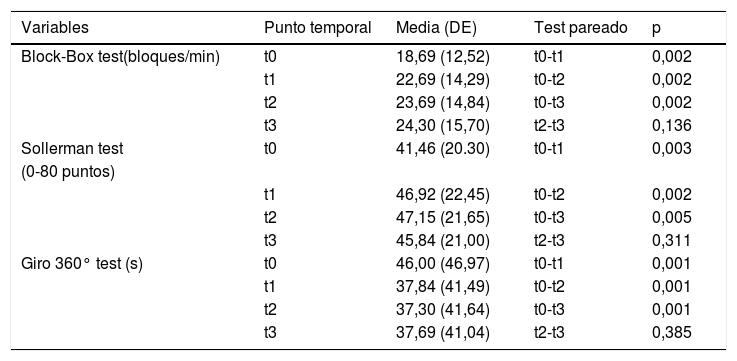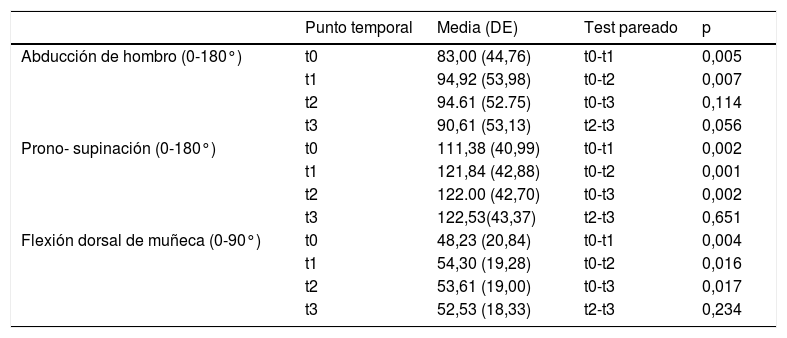La recuperación de la función de la mano es uno de los aspectos más complejos para los pacientes que han sufrido las secuelas de un daño neurológico.
ObjetivoEvaluar los efectos a corto plazo sobre el miembro superior afectado de la realización autónoma de un ejercicio de locomoción refleja adaptado a la sedestación en el paciente neurológico crónico.
MétodoDiseño pretest-postest. Participaron 13 pacientes (8 mujeres) con edad media de 47,61 (DE 16,03). Posibilidad de pinza y abducción de hombro mínima de 30°. Se realizaron 3sesiones en 2semanas consecutivas, entrenando al paciente para realizar el ejercicio en su casa sin ayuda. Se valora el efecto de la terapia antes y después de la primera sesión, a las 2semanas y 3meses después. Se midieron la prensión con el test de Sollerman y la velocidad y la función global del brazo afecto con el Box-Block test.
ResultadosEn la 1.ª sesión en Box-Block pasó de 18,6 a 22,6 cubos (p <0,002). Resultados mantenidos en 2.ª y 3.ª evaluación. En el Sollerman test, pasó de una media de 41,4 a 46,9 puntos (p <0,003) en 1.ª evaluación y 47,15 puntos en 2.ª (p <0,002). A los 3meses se mantienen los efectos (0,005).
ConclusionesLa aplicación de un programa de locomoción refleja adaptado a la sedestación en pacientes con secuelas en el miembro superior, ofrece la posibilidad al paciente de autogestionar la terapia aumentando su intensidad. Se mejoran con ello la función y la movilidad del miembro superior a corto plazo.
The recovery of hand function is one of the most complex aspects for patients who have suffered the sequelae of neurological damage.
ObjectiveTo evaluate the short-term effects on the affected upper limb of the autonomous performance of a reflex locomotion exercise adapted to sitting in chronic neurological patients.
MethodPretest–postest design. Thirteen patients (8 women) participated with a mean age of 47.61 (SD 16.03). Possibility of clamping and minimum shoulder abduction of 30°. Three sessions were held in 2consecutive weeks, training the patient to perform the exercise at home without assistance. The effect of the therapy is assessed before and after the first session, at 2weeks and 3months later. Grip was measured with the Sollerman test, and the speed and global function of the affected arm with the Box–Block test.
ResultsIn the 1st session in Box–Block it went from 18.6 to 22.6 cubes (P<.002). Results maintained in 2nd and 3rd evaluation. In the Sollerman test, it went from an average of 41.4–46.9 pts. (p<.003) in 1st evaluation, and 47.15 pts. in 2nd (P<0.002). After 3months the effects are maintained (.005).
ConclusionsThe application of a reflex locomotion program adapted to sitting in patients with sequelae in the upper limb, offers the patient the possibility of self-managing therapy by increasing its intensity. This improves the function and mobility of the upper limb in the short term.
Artículo
Si ya tiene sus datos de acceso, clique aquí.
Si olvidó su clave de acceso puede recuperarla clicando aquí y seleccionando la opción "He olvidado mi contraseña".












